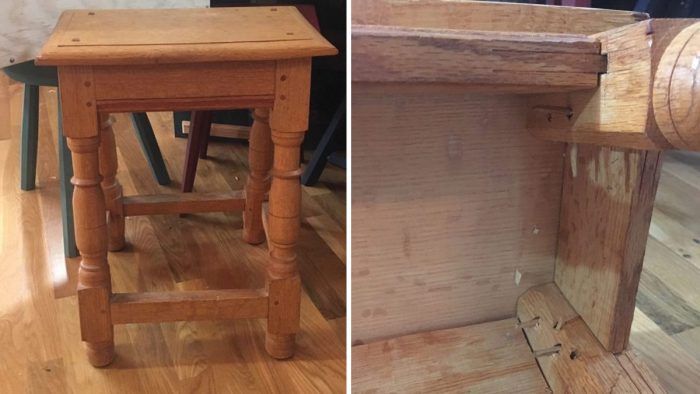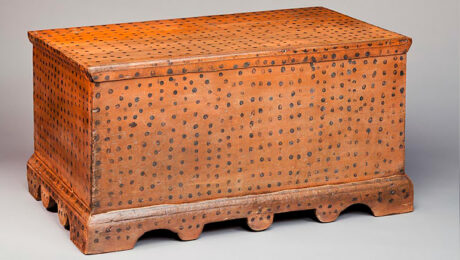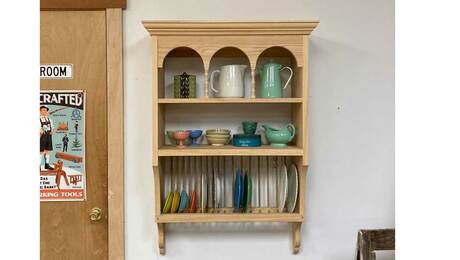Don’t knock the last person’s work
Some people criticize others’ work to make themselves look better in the eyes of prospective customers. But Nancy Hiller argues that this is a dangerous way of doing business.
Some people criticize others’ work to make themselves look better in the eyes of prospective customers. There’s almost always something you can criticize—less than perfect joinery, the use of “inferior” hardware, the underside of a chair or table that was finished to a lower standard than the top. If pointing out such things implies that you work to higher standards, it may help you get the customer’s next job. But as a professional woodworker, I’ve learned to be careful about knocking others’ work as a way of suggesting that mine is better.
Ultimately what differentiates professionals from those who are not professionals is not their level of expertise or the standard of their work, but whether they make a living from it.* Sure, when we say that John’s highboy and Mary’s video were made to professional standards, we’re using the word “professional” to denote a high level of craft, but this use does not define the word. I know retired engineers and still-employed philosophy professors, federal workers, and high-school English teachers who are accomplished furniture makers. Sometimes their work is made to a higher standard than that of professionals.
If furniture making is your hobby and something you’re really serious about, you may, like many others, spend your vacation time taking classes. (For that matter, you may have vacation time.) Your income may have allowed you to put together a shop that’s larger and outfitted with far better equipment than that of many professional woodworkers. If you’re building a William and Mary couch or a Wooton desk in your spare time, you may invest as many hours as you wish. Go to town on the details. Let your inner perfectionist reign!
 |
 |
When furniture making is your livelihood, projects usually come with constraints. While it’s true that some customers are financially able to give a craftsperson free rein because they value his or her work so highly, most customers have a budget and at least a vague idea of a preferred deadline in mind**. Do I know how to build furniture with meticulously fitted inset doors hung on traditionally mortised butt hinges? I do. Do I sometimes build furniture with full-overlay doors hung on European-style hinges? I do. The type of door construction, fitting, and hardware I use will vary depending on the style in which I’m working. But it may also be influenced by my customer’s budget. Even though I’ve spent most of my career building furniture and cabinets with inset doors hung on traditional butts (translation: I’m relatively quick at it), I can still fit full-overlay doors (and inset doors) on European-style hinges faster, because the hinges are easy to adjust. If my customers’ budget will only allow for European hinges, fine. Just don’t come along and criticize the job on the grounds that it was built with “inferior” hardware, because the hardware was integral to the job’s specifications. Long before you came along to criticize, I informed the customer of all the pros and cons of each type of hardware and allowed her to decide for herself.
Just as important, different styles and traditions in furniture making have historically called for different levels of finishing on distinct parts of a job. During my training I was taught to finish the underside of a piece to the same standard as the top. This, my instructor emphasized, was simply a matter of craftsmanship. Then I went to work in shops run by others, who insisted I limit this level of care to the parts of jobs that are regularly seen. In terms of function, there was no lessening of quality, but reducing the labor invested kept the work more affordable. Beyond this, when it comes to furniture that continues a historical tradition, such as work done in medieval, Colonial, or various vernacular styles, finishing the underside of a stool or table to the same standard as that of the outside or top violates the historical ethic integral to the style. This is a case where “more” is not “better.”
 |
 |
On those occasions when I do make critical remarks about what the last person did, I qualify them by explaining the points I’ve made above. I want the customer to know I’m not taking an easy shot at the last guy. You simply can’t know all the variables unless you were part of the original negotiation on which the job you’re criticizing was based. And if you go around knocking other people’s work, you’re contributing to a culture that may well come back to bite you, regardless of how good you are.
*Oxford English Dictionary
**The uses of “reign” and “rein” here are correct. “Reign” means rule. “Rein” is a means to control, usually plural, as in a horse’s reins. To give someone free rein is to relinquish control, to allow her to run as fast as she wants.
Nancy Hiller is a professional cabinetmaker who has operated NR Hiller Design, Inc. since 1995. Her most recent books are English Arts & Crafts Furniture and Making Things Work, both available at Nancy’s website.
More on FineWoodworking.com:
- Loose-pin butt hinges: a little play may be better than none by Nancy R. Hiller
- Business Insurance Is Non-Negotiable–Nancy Hiller’s livelihood is almost entirely dependent on her shop, and while insurance premiums are expensive she can’t afford to not pay them
- Nancy Hiller’s Reality Check(list) – If you’re thinking of turning your passion into a profession you should take a deep look at what is involved in running a legitimate business.






















Comments
So incredibly true. I wince when I see and hear people trying to knock the work they’re either replacing or fixing, for exactly what you just mentioned. We don’t know what the client was willing to pay for and to whom. And I’ve never made or installed a thing that had zero flaws, regardless of what I was trying to do, so who would I be to judge?
I find it more rewarding and positive to point out what had been done right, and show diplomacy while subtly trying to decipher what is important to a client and accommodate when prioritizing cost vs time vs quality, quality has the least wiggle room and there’s so much more to it than that anyway. Also, not slagging others sets a tone that makes for a better work environment.
You’re singing my song, lady. Great post.
Thanks for your comment, Marc. Having met you and seen a tiny bit of your work, I appreciate your thoughts all the more.
Fantastic article, and quite apt. I am often in the position of repairing broken musical instruments and when asked why something broke there are usually only two reasons - abuse or inferior construction. Both are difficult to talk about with a customer and the second is only made easier when I can also talk about the limits of mass production and overall cost. Telling a customer that they abused something is difficult because nobody admits they stepped on a guitar of stored it improperly!
Last, I found the minutiae explaining word choice funny and discomfiting the grace with which the article was written. In writing and speaking I always make the leap that the audience can understand me and will ask questions if they cannot. Adding the footnote is curious - was it necessary?
jhonbaker, thanks for your comment. The idea of someone not copping to having stepped on a guitar is hilarious and a little scary. It makes me think of a former boss of mine who told me that some customers complained about the quality of their cabinets' finish and insisted he come take a look. He said it was obvious that their dogs had scratched the cabinets, but when I pointed this out they continued insisting that the problem was with the finish. He ended up replacing a good bit of the kitchen--not because the fault lay with the cabinets, but because the people were not going to give in, and it was easier to placate them.
I appreciate your note about the words. I've seen these two words confused so often, even by professional writers and editors, that in this case I thought it was worth adding the note. I don't mean to be overbearing or come across as a school-marm. I will try to be less proactive/defensive!
I just saw this article (only a month late). I was told, by my father, at a young age,"it's easy to be a critic". I have always lived by this philosophy. One does not always know the history.
Amen.
I absolutely love this article and have referred back to it frequently over the past 12 months. On this particular day, I had a conversation with my 8th-grade son who was evaluating his own work at the expense of a classmate's work in their art class. While not woodworking, art is also subject to the same constraints as furniture projects - time, cost, customer choice, etc. Thanks for posting these types of comments, as they seem to have more impact coming from someone other than "just dad".
Log in or create an account to post a comment.
Sign up Log in